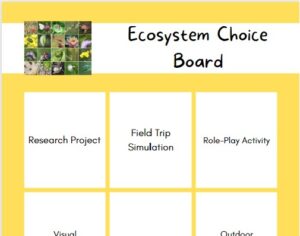In the first article of this series, we examined some common misconceptions about differentiation. In this article, we’ll explore the benefits that students receive from differentiated instruction. Being familiar with these benefits will help you implement differentiation in your classroom with more purpose and confidence.
To illustrate the benefits, let’s start with an example of a teacher differentiating process in her class.
Example: A middle school science teacher is teaching a unit on ecosystems. The teacher uses a choice board as one method of differentiation.
A choice board is a grid that provides students with a variety of learning activities related to a specific topic or concept. Each activity on the board is designed to address different learning styles, interests, and abilities. Students are given the freedom to choose which activities to complete based on their preferences and strengths.

The activities for this choice board include:
- Research Project: Students can choose to research a specific ecosystem (e.g., rainforest, desert, ocean) and create a presentation or poster highlighting its features, inhabitants, and environmental challenges.
- Field Trip Simulation: Students can choose to design a virtual field trip using technology tools, where they describe a visit to an ecosystem and explain its characteristics.
- Role-Play Activity: Students can choose to take on the role of different organisms in an ecosystem and participate in a role-play activity that demonstrates the interdependence of these organisms.
- Visual Representation: Students can choose to create a visual representation (e.g., a diorama, infographic, or comic strip) that illustrates the key components of an ecosystem.
- Outdoor Exploration: Students can choose to go outdoors, observe a local ecosystem, and then write a reflective journal entry about their observations and insights.
Increases Student Engagement
By providing students with these choices, the teacher caters to various learning styles, interests, and abilities. Students are more likely to engage with the content because they feel a sense of autonomy and ownership over their learning. They are motivated to select activities that align with their strengths and preferences, leading to increased enthusiasm and investment in the subject matter.
Increased Student Understanding

So in the example above, students are afforded the opportunity to deepen their understanding of the topic when the teacher gives them chance to explore in ways that resonate with them personally. By addressing students’ varying learning styles and preferences, differentiation enhances their understanding of the material. Visual learners might benefit from diagrams, kinesthetic learners from hands-on activities, and auditory learners from discussions, all of which are possible through differentiation.
Fosters Independence

Using a choice board to differentiate instruction fosters independence by giving students the autonomy to select learning activities aligned with their preferences and strengths. This approach encourages them to take ownership of their learning journey, make decisions that suit their individual needs, and develop a deeper understanding of their learning styles. Through this process, students learn to manage their time, make informed choices, and become accountable for their own learning, building essential skills for self-directed learning.
Differentiation encourages students to take ownership of their learning. When students have choices in how to approach assignments and tasks, they develop critical thinking skills, problem-solving abilities, and a sense of responsibility for their own education.
Differentiation offers a multitude of benefits that enhance both student engagement and achievement. By tailoring instruction to individual learning needs, differentiation cultivates a more inclusive and motivating classroom environment, fostering independent and self-directed learners. The ability to cater to diverse learning styles, abilities, and interests not only ensures that every student can excel but also instills a lifelong love for learning. In the upcoming blog post, we will delve into the practical aspects of differentiation, exploring three key elements teachers can differentiate to create a dynamic and responsive learning experience for all students. Stay tuned to discover actionable strategies that empower educators to create vibrant and effective classrooms.

